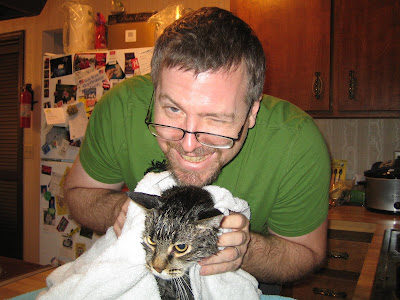FOR MY SINS I LIVE IN BRISBANE
Grace Dugan, guest blogging
Let me start by telling you a bit about our lovely city, which will be the backdrop for some of Jeff’s adventures in Australia.
(First aside: I’m annoyed that Trent beat me to this, but I wrote it last weekend, before I even knew he was writing one! So you’re going to have to suffer my introduction as well)
(Second aside, for other Brisbanites: I’m going to romanticise it a bit, so don’t write in and correct me or anything, okay?)
Brisbane is a city of around one million people, on a latitude about equivalent to Miami. I suspect we get cooler winters than Miami, but basically it’s pretty hot here, rains mostly in summer, lots of green things growing around the place. It’s on a biggish river which flows into Moreton Bay, and does not have any trendy beachside suburbs. But there’s the Sunshine Coast to the north, and the world famous (but mostly disliked by Brisbanites) Gold Coast to the south.
A lot of people in Brisbane don’t like Brisbane. If you go to the Valley markets on a Saturday morning, you can buy any one of a series of t-shirts to express your possibly ironic dislike of the city. They say things like: For my sins I live in Brisbane, Brisvegas where’s everyone’s a winner baby, and Brisbane warped my fragile mind. (Don’t ask me why people call it Brisvegas, ask someone else). Australians in general suffer from cultural cringe, which is where we don’t think we’re good enough and where we constantly look to the outside for validation. Brisbane suffers from its own extra dose of it in relation to Sydney and Melbourne.
The flipside of cultural cringe, though, is an kind of jingo-istic, defensive love of the city. This seems to be especially true in recent years. Brisbane is the fastest growing city in Australia, has a skyline full of cranes, new shopping centres every month, soaring real-estate prices, a rapidly gentrifying inner city, and an air of self-congratulation. Brisbane is the new black, apparently. We now have more clothes boutiques, wine bars, delis and fancy restaurants than we’ve ever had before.
We also have a powerful city council. Unlike Sydney and Melbourne, Brisbane is not broken up into separate local government areas, and is in fact the largest city or shire in Australia. The council has a fairly strong influence on the literary scene. For the last few years, they’ve had a One Book One Brisbane reading campaign (although last year it was in fact Two Books One Brisbane because of a stuff up in the way it was organised). Now they’re changing it to One Book Many Brisbanes, an (annual?) anthology of stories by local writers set in Brisbane. Some writers have quite a high profile here, most obviously Nick Earls, who was in a major ad to promote the city, but there are others too.
So this would all be a good thing? Maybe, maybe not. I like the idea of writing about Brisbane, as long as we’re allowed to trash it and burn it and show it as ugly and doomed and evil. As long as we don’t all have to be celebrating the sinuous curves of the river and the optimism of economic growth, writing cutesy stories about sharehousing in Taringa or café dramas of New Farm. The literary history of Brisbane doesn’t go back very far. Probably our most celebrated author is David Malouf, who wrote these lines about the city, which you can find on a plaque on the pavement in Albert St: “Brisbane is so sleepy, so slatternly, so sprawlingly unlovely! I have taken to wandering about after school looking for one simple object in it that might be romantic, or appalling even, but there is nothing. It is simply the most ordinary place in the world.” I believe it’s from Johnno.
So, most important of all, what is it like here? The sun is really bright, yet we hardly ever wear hats. Green things grow everywhere, especially monsteras, jacarandas, bougainvilleas and poincianas. In the warmer months, suburban gardens fill the streets with the scent of frangipani, yesterday today and tomorrow, mock orange and star jasmine. The river meanders, so that if you stand in the middle of town, you can walk one way and get to the river, but if you walk the opposite way you’ll also get to the river. Most of it’s bright and shiny. Our old heritage buildings were knocked down by our fascist premier in the 80s, and everything else gets rebuilt every ten years; there’s a general lack of urban grit. Our old houses are wooden, stand up on stilts above the ground, and have big verandas. They get moved around every now and then, so sometimes if you’re up in the middle of the night you will see a truck driving by very slowly, carrying an entire house on its back, taking it further out into the suburbs so that it can make room for a block of six apartments.
It’s a nice place to live.
Grace Dugan’s first novel The Silver Road is coming out from Penguin Australia in 2006.



2 Comments:
Beautiful writing - very vivid - thank you.
The earliest I remember hearing Brisvegas was the early nineties, though it could have been around before that.... I always took it as an ironic comment on our image as a "big city"...
I agree with you about art serving as a tourism advert... the only people fooled by that are other tourism boards...
Post a Comment
<< Home